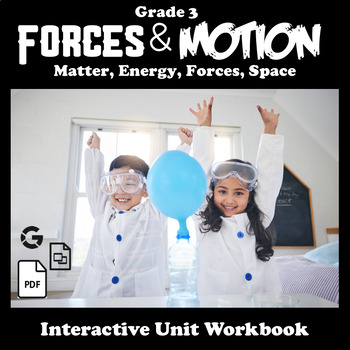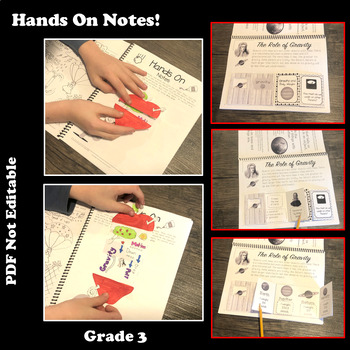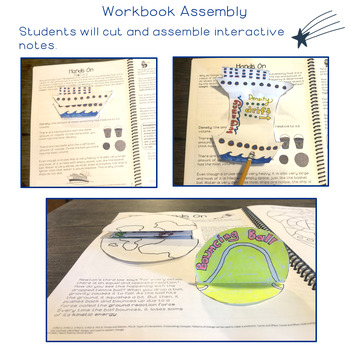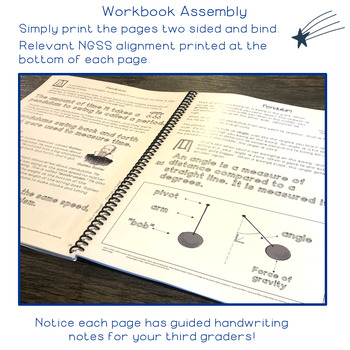Forces and Motion Interactive Notebook | Third Grade 3-PS2-1
- Zip
Description
Introducing our 3-PS2-1 aligned Third Grade Forces and Motion Interactive Notebook, a dynamic forces and motion resource, designed to engage young minds in the fascinating world of science. Ideal for educators seeking to provide students with a hands-on science workbook, fostering a deeper understanding of concepts. This interactive notebook serves as a powerful tool, keeping students motivated, engaged, and facilitating better retention of their learning.
↑ .·:*¨↑¨* ≈☆ Over 150 Pages and Slides☆≈ *¨↑¨*:·. ↑
Standards: 3-PS2-1, 3-PS2-2, 3-PS2-3, 3-PS2-4, PS2.A: Forces and Motion, PS2.B: Types of Interactions. Crosscutting Concepts: Patterns of change can be used to make a prediction. Cause and Effect: Cause and Effect relationships are routinely identified, tested, and used to explain change. Also complies with TEKS.SCI.3.2.D TEKS.SCI.3.2.B TEKS.SCI.3.2.C TEKS.SCI.3.2.F TEKS.SCI.3.2.E
╰┈➤ ╰┈➤ ╰┈➤ ╰┈➤ ╰┈➤ PREVIEW VIDEO ⥉ ⥉ ⥉ BY THE THUMB NAIL ► ▌▌ ■
Explore the preview video above to get a glimpse of our exciting workbook and THREE FREE GIFTS YOU RECEIVE! By watching the preview, you'll unlock TWO FREE EXPERIMENTS from this comprehensive resource and gain FREE ACCESS TO OUR GOOGLE SLIDES. To claim your experiments and Google Slides access, download your free experiment HERE. Plus, discover additional perks by signing up for our email list included with the free product. Once you sign up for the email, this entire Google Slides you see in this video is also yours!
How to Open: This product comes in a ZIP FILE containing the workbook. The second document contains Quizzes, Homework Answers, Unit Test and Answers. The third file contains everything you need for the interactive pages. Make sure you know how to open a zip file before purchase.
How to Use: Teachers can easily print this workbook using two-sided printing and binding, creating a comprehensive and organized notebook for students. With a specially designed handwriting font, students actively participate in the learning process as they write notes, reinforcing their understanding of science concepts while enhancing their handwriting skills. The real fun begins as students assemble interactive notes, making learning an enjoyable experience.
Topics Covered: Aligned rigorously with NGSS standards, this notebook spans a wide array of topics: from understanding how things move to exploring Newton's laws of motion, forces like gravity and magnetism, and even diving into concepts like solar flares, aurora lights, friction, buoyancy, and more. Students will also delve into the discoveries of prominent scientists such as
- Isaac Newton
- Galileo Galilei
- Vera Rubin
- Jocelyn Bell Burnell
- Neil de Grasse Tyson
- Caroline Herschel
- Hans Oersted
Included Materials: Homework assignments with answers, practice unit quizzes, and a comprehensive unit test with answers facilitate learning and assessment. Additionally, a set of thirty Google Slides accompanies the workbook, aiding teachers in interactive teaching sessions by visually showcasing interactive notes and discussing homework pages.
Experiments: The workbook incorporates six engaging experiments, each featuring informational text, guided notes, a data log page, and success criteria. Encouraging student-led discovery, these experiments align seamlessly with NGSS standards, promoting hands-on learning.
Woman's History Month: This product contains three biographies for Vera Rubin, Joyce Burnell and Caroline Herschel, women who made important contributions to physics and astronomy. We've also included videos about these women in our video library.
Forces and Motion in Space: The final segment of the workbook explores forces and motion in space, covering essential aspects such as the nature of space, gravity's role in a vacuum, the speed of light, and fascinating phenomena like the bending of spacetime and light. Delving deeper, students explore the discovery of pulsar stars and dark matter, connecting scientific principles to astronomical wonders.
Student Assessment: To ensure continuous improvement, a student assessment section empowers students to reflect on their learning experiences, providing valuable feedback to enhance future learning.
Our Third Grade Forces and Motion Interactive Notebook is an immersive educational tool that not only meets educational standards but also ignites a passion for scientific exploration and understanding in young learners.
✅ Look for the green star next to my store logo and click it to become a follower. You will receive Free Updates
How to get TPT credit to use on future purchases:
- Please go to your “My Purchases” page (you may need to login). Beside each purchase you'll see a Provide Feedback button. Simply click it and you will be taken to a page where you can give a quick rating and leave a short comment for the product.
- Each time you give feedback, TPT gives you feedback credits that you use to lower the cost of your future purchases. I value your feedback greatly as it helps me determine which products are most valuable for your classroom so I can create more for you.
If you liked this product, you will certainly like these
Titan Implosion | Physics of Marine Energy Transfer
Oppenheimer | Math and Physics of Nuclear Fission
Nuclear Fission | Nuclear Science Lesson
Three Levels of Photosynthesis
Three Levels of Theoretical Physics
Three Levels of Falsifiability | Philosophy of Karl Popper
Three Levels of The Speed of Light
Three Levels of Light years | Measuring Distance in Space
Three Levels of Electromagnetism | Differentiated Reading Strategy
Three Levels of Solar Wind | Astronomy Differentiated Reading Strategy





